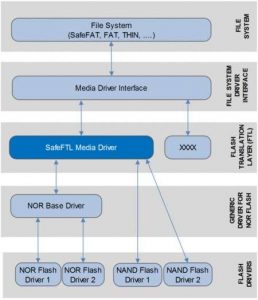HCC Embedded Validates SafeFTL for Micron Automotive SPI NAND Flash
Provides failsafe flash translation layer management for entire range of Micron SPI NAND flash memories.
This is a Press Release edited by StorageNewsletter.com on April 25, 2019 at 2:47 pmHCC Embedded announced that its fail-safe Flash Translation Layer (SafeFTL) has been tested and verified for the entire range of automotive-grade SPI NAND flash memory products from Micron Technology, Inc.
Click to enlarge
Automotive designers integrating SPI NAND flash into automotive systems can use the SafeFTL to ensure the reliable storage of data to the NAND flash.
The company tested Micron’s one, two, four, and 8Gb flash devices with 1.8V and 3.3V interfaces. These devices operate across a temperature range of -40°C to +105°C. To test the memory devices, the firm mounted them on a Secure Digital (SD) form factor board for an easy, straightforward interface to development boards with SD card slot support for SPI communication.
“HCC has a 15-year track record in failsafe NAND flash management and fail safety, and we’ve put in the extra time and effort to test the Micron automotive NAND devices individually to validate them for use with our SafeFTL product,” said Dave Hughes, CEO, HCC. “Automotive engineers – and any engineers looking for reliable storage solutions using SPI NAND flash – can use our field-proven fail safe flash translation layer to bring added reliability to their designs.“
SafeFTL is designed for integration with any embedded system, independent of RTOS, to allow an array of NAND flash devices (or single device) to be seen as a dependable logical array of sectors by the host application. This is typically, but not necessarily, a file system. When used in combination with the company’s various fails afe file systems, a complete and reliable storage solution can be presented to automotive applications.
Further, using the firm’s SafeFTL, the operations on the flash can be managed by the host system to guarantee deterministic execution time such that there are no unexpected stalls when managing the NAND flash.














 Subscribe to our free daily newsletter
Subscribe to our free daily newsletter

